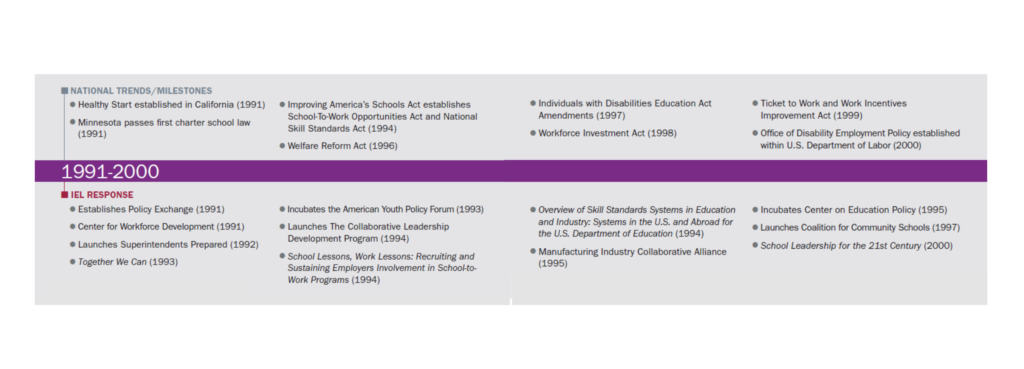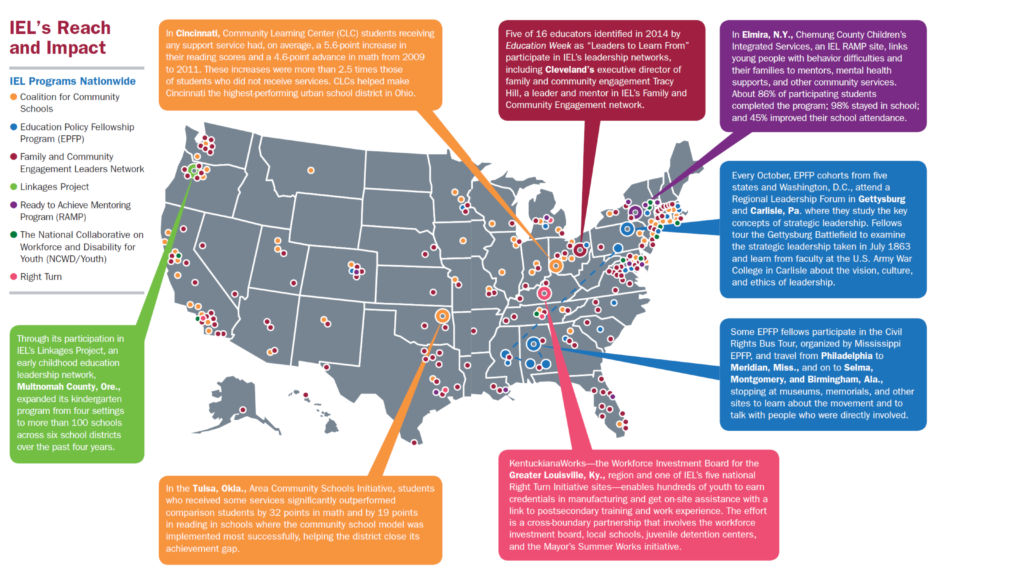Since 1964, IEL has championed the need for leaders at all levels to shake off their institutional constraints and work together to address the needs of children, youth, and families.
IEL’s programs have helped define national and state policies in education and workforce development, enabled leaders to build collaborative strategies that get results, and assisted practitioners to implement quality practices, leading to better outcomes for our young people.

To learn more about our five decades of impact and our plans to continue to shape and strengthen leadership to serve the next generation of young people over the next 50 years, read our 50th anniversary booklet, “Cross-Boundary Leadership for the Common Good.” Also read our “Leadership Lessons for the 21st Century.”
Highlights from IEL's History as a Change-Agent
IEL was established in the 1960s to help identify, prepare, and support a new cadre of leaders in education. Through its Washington
Internships in Education (WIE) program, IEL facilitated the newly expanding federal role in education and ensured greater diversity
in leadership. IEL also created opportunities to promote bipartisan decision making in Congress to shape and strengthen
implementation of ESEA.
In the 1970s, WIE became the Education Policy Fellowship Program (EPFP) and emerged as a state-based, mid-career leadership development program. With power shifting to the states, IEL developed the State Education Policy Seminars, creating venues for policy deliberation and collaboration in 40 state capitals.
To meet the demands of the Education for All Handicapped Children Act of 1975 (the precursor to the Individuals with Disabilities Education Act), IEL worked to develop two generations of special education policy leaders.
During its second decade, IEL also pioneered the Family Impact Seminar, adapting lessons from environmental impact studies to explore how to leverage federal policy to support families, and launched a journalism fellowship program and a nationally syndicated radio show on NPR.
In the 1980s, IEL launched a series of pathbreaking studies to help leaders begin to understand pending demographic trends that have since transformed our nation. All One System and The Same Client argued that our education system should be “a seamless web”
from pre-K through graduate school, and that schools and agencies that serve the same children and families need to better coordinate
their efforts.

IEL also focused in the 1980s on the long-ignored role that local school boards could play in their communities and education reform.
Over time, it incubated important, nationally influential organizations and policy initiatives, including The Hispanic Policy Development
Project, Jobs for the Future, the American Youth Policy Forum, and the Center on Education Policy.
In the 1990s, IEL launched the Center for Workforce Development, which helps leaders and stakeholders promote career-readiness and successful transitions to adulthood with a special focus on youth with disabilities and other disconnected youth. IEL also established Superintendents Prepared to help create a larger and more diverse group of superintendents, and it began to focus on school-family-community partnerships, introducing the Together We Can Initiative, aimed at helping education and human services systems work together to develop pro-family policies and practices.
As national priorities have shifted through the years, IEL has remained steadfast in its focus. The organization has withstood the test of
time by continuing to anticipate and tackle burning issues, to catalyze new ideas and networks, and to keep a laser-like focus on leadership development and equity.

3 Pillars of Success
Since 2000, IEL has applied its core values and strategies to focus on three pillars of success to buttress families and help young people thrive.
IEL sparked the nation’s efforts to return schools to their significant role as centers of their communities. The Coalition for Community Schools helps ensure that students and their families have access to coordinated academic, youth development, health, and social services connected to their public schools. This work is happening in more than 100 school districts, supported by the Community Schools Superintendents Leadership Council, the Community Schools Leadership Network, and the District Leaders Network on Family and Community Engagement. These peer-learning and action networks build local capacity to improve the learning and development of young people and support their families.
IEL has improved the capacity of policymakers, program administrators, and youth service professionals to provide comprehensive,
coordinated transition services for all youth, including those with disabilities. Its work distilling research into innovative strategies such as the Guideposts for Success and the Youth Services Professionals’ Knowledge, Skills & Abilities Initiative has influenced policy and practice about successful transitions to adulthood. IEL has used research to design programs such as High School/High Tech, RAMP, and Right Turn, which leverage the expertise of local businesses, community organizations, and schools to create new career pathways for disabled, disengaged, and disadvantaged youth.
IEL’s Education Policy Fellowship Program (EPFP) continues to provide leadership, policy, and networking experiences for a wide range of professionals in the early childhood, K-12, and higher education policy fields. More than 8,000 people in 46 states and the District of Columbia have cycled through EPFP, taking on roles in improving policy, practices, and partnerships at the federal, state, corporate, and community levels. IEL’s growing emphasis on developing the leadership and coalition-building skills of people working with parents, families, and school leaders extends IEL’s leadership development role deep into grassroots efforts strengthening schools and communities.


IEL continues to catalyze new ideas and approaches as it looks to its next 50 years. IEL will amplify its work by building and supporting broad-based networks of cross-sector leaders so that best practices can be brought to scale, supported by responsive state and federal policy.
